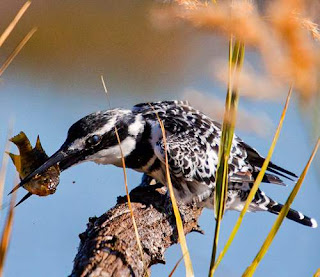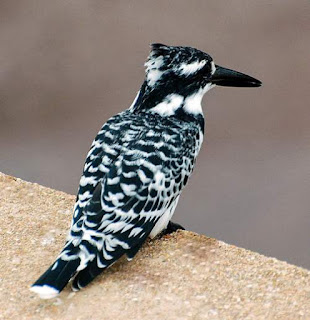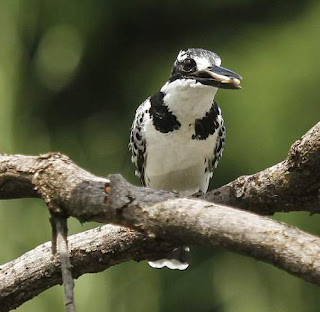Taxonomic classification <> Photos
The pied kingfisher (Ceryle rudis) belonging to the family Alcedinidae under the order Coraciiformes.
Cooperative breeding in Pied kingfisher
The species Ceryle rudis are quite gregarious and they congregate at communal roosting sites at night. Quite often cooperative (communal) breeding is observed in these species of birds.The non-breeding siblings from earlier brood have been found to help the parents in raising the hatchlings; sometimes even unrelated older birds have been found to help.
The adult male and female ratio of these species is skewed and there is surplus of males probably due to a higher mortality rate among the breeding females. The incubating and brooding activity at night is done exclusively by the female.
Consequently, the females are more exposed to dangers like caving in of nesting tunnels, flooding and nest predation. Many of the surplus males take up the role of primary/secondary helpers, assisting the breeding pair in protecting the nesting site as well as bringing food for the nestlings.
| Taxonomic classification | |
|---|---|
| Binomial name: | Ceryle rudis |
| Species: | C. rudis |
| Genus: | Ceryle |
| Subfamily: | Cerylinae |
| Family: | Alcedinidae |
| Order: | Coraciiformes |
| Class: | Aves |
| Phylum: | Chordata |
| Kingdom: | Animalia |
 |
| 1.Pied kingfisher - Ceryle rudis Photo by Hans Hillewaert |
 |
| 2.Pied kingfisher - Ceryle rudis Photo by Hein waschefort |
 |
| 3.Pied kingfisher - Ceryle rudis Photo by Harvey Barrison |
 |
| 4.Pied kingfisher - Ceryle rudis Photo by Leo za1 |
 |
| 5.Pied kingfisher - Ceryle rudis Photo by Leo za1 |
 |
| 6.Pied kingfisher - Ceryle rudis Photo by Ji-Elle |
 |
| 7.Pied kingfisher - Ceryle rudis Photo by Charlesjsharp |
 |
| 8.Ceryle rudis Photo by Artemy Voikhansky |
 |
| 9.Ceryle rudis Photo by stuart Burns |
 |
| 10.Ceryle rudis by Charlesjsharp |
1.Photo source: https://commons.wikimedia.org/wiki/File:Ceryle_rudis_(male).jpg (cropped)
Author: Hans Hillewaert | License: CC BY-SA 3.0
2.Photo source: https://commons.wikimedia.org/wiki/File:Pied_kingfisher_killing_fish.jpg (cropped)
Author: Hein waschefort | License: CC BY-SA 3.0
3.Photo source: https://commons.wikimedia.org/wiki/File:Ceryle_rudis_-Kruger_National_Park,_South_Africa-8_(2).jpg (cropped)
Author: Harvey Barrison | License: CC BY-SA 2.0 as on 5/26/17
4.Photo source: https://commons.wikimedia.org/wiki/File:Austin_Roberts_Bird_Sanctuary-048.jpg (cropped)
Author: Leo za1 | License: CC BY-SA 3.0
5.Photo source: https://commons.wikimedia.org/wiki/File:Austin_Roberts_Bird_Sanctuary-018.jpg (cropped)
Author: Leo za1 | License: CC BY-SA 3.0
6.Photo source: https://commons.wikimedia.org/wiki/File:Lac_Ha%C3%AFk-Ethiopie-Martin-p%C3%AAcheur_pie_(3).jpg (cropped)
Author: Ji-Elle | License: CC BY-SA 3.0
7.Photo source: https://commons.wikimedia.org/wiki/File:Pied_kingfisher_(Ceryle_rudis_rudis)_female.jpg (cropped)
Author: Charlesjsharp | License: CC BY-SA 4.0
8.Photo source: https://commons.wikimedia.org/wiki/File:Pied_kingfisher_in_flight.jpg (cropped)
Author: Artemy Voikhansky | License: CC BY-SA 4.0
9.Photo source: https://commons.wikimedia.org/wiki/File:Birds_1010159_(31516478876).jpg (cropped)
Author: stuart Burns | License: CC BY 2.0 as on 5/27/17
10.Photo source: https://commons.wikimedia.org/wiki/File:Pied_kingfisher_(Ceryle_rudis_rudis)_male.jpg (cropped)
Author: Charlesjsharp | License: CC BY-SA 4.0
Current topic in Birds of India: Pied kingfisher (Ceryle rudis) photos.